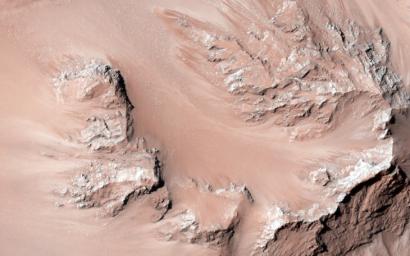
|
Active Slope Flows on the Central Hills of Hale Crater
- Click the image above for a larger view
- Full-Res JPEG (2880 x 1800) (579.8 kB)
- Full-Res TIFF (2880 x 1800) (15.6 MB)
Caption:
HiRISE has been monitoring steep slopes on Mars because some of them reveal active processes. In some cases, there are many seasonal flows on warm slopes, suggesting some role for water in their activity.
The central hills in Hale Crater is one such location, with thousands of seasonal flows on steep slopes below bedrock outcrops. The cutout shows a small sample of this image, with relatively dark and reddish lines extending onto sediment fans.
These lines grow slowly over several months time, fade and disappear in the cold season (southern winter), then reform the next warm season (southern spring and summer).
Background Info:
HiRISE is one of six instruments on NASA's Mars Reconnaissance Orbiter. The University of Arizona, Tucson, operates the orbiter's HiRISE camera, which was built by Ball Aerospace & Technologies Corp., Boulder, Colo. NASA's Jet Propulsion Laboratory, a division of the California Institute of Technology in Pasadena, manages the Mars Reconnaissance Orbiter Project for the NASA Science Mission Directorate, Washington.
Cataloging Keywords:
| Name | Value | Additional Values |
|---|---|---|
| Target | Mars | |
| System | ||
| Target Type | Planet | |
| Mission | Mars Reconnaissance Orbiter (MRO) | |
| Instrument Host | Mars Reconnaissance Orbiter | |
| Host Type | Orbiter | |
| Instrument | High Resolution Imaging Science Experiment (HiRISE) | |
| Detector | ||
| Extra Keywords | Color, Crater, Water | |
| Acquisition Date | ||
| Release Date | 2013-05-29 | |
| Date in Caption | ||
| Image Credit | NASA/JPL-Caltech/Univ. of Arizona | |
| Source | photojournal.jpl.nasa.gov/catalog/PIA17734 | |
| Identifier | PIA17734 | |
